Introduction
HR has a big part to play in planning the return to work from COVID-19, both in setting up the office ahead of employees coming back and maintaining ongoing safety protocols and outbreak preparedness.
At the end of April and the beginning of May 2020, HiBob conducted an in-depth market research study with a representative sample of 1,000 employed adults in the U.S. in order to understand attitudes and opinions about the results of the world’s biggest experiment of remote work and productivity. Almost overnight, millions of people were asked to stay at home in order to stay safe, avoid commuting, practice physical distancing, and work from home. Some had never worked from home in the past, some were experienced. Most people were grateful to be able to keep their jobs while working from home. During the COVID-19 pandemic, we realized working from home is both the safe option and the productive one. We overcame less-than-ideal WFH setups and adapted our lives to the rapidly-evolving new normal.
These times presented a challenge for even seasoned WFH workers because they weren’t just working from home, but they were doing so in a packed household during a pandemic. Still, people managed to be productive and deliver results. In addition to collecting answers to the questions about WFH productivity and willingness to come back to work from the office, we asked people as to their age, seniority at work, living arrangements, and gender in order to understand how this unique work experience was influenced by these personal circumstances. Surprisingly, we found that productivity while working from home was mostly influenced by communication with your company, your direct manager, and your teammates and less influenced by unique personal circumstances.
The following is the analysis of the results to our questions in general and zooming into demographics and attitudes towards the WFH experience.
Communication was key during this abrupt change
Ongoing frequent communications increases confidence in the company’s ability to overcome the crisis.
How confident are you in your company’s ability to overcome the challenges caused by COVID-19?
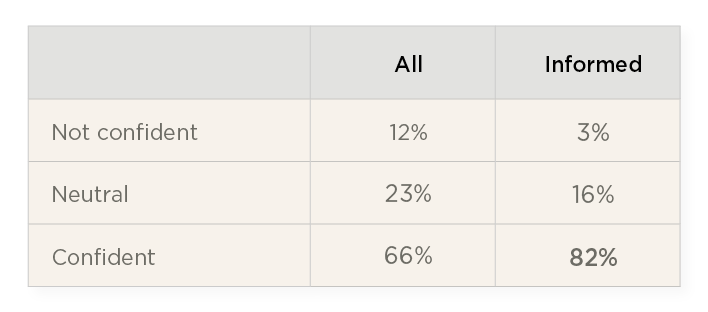
66% of employees are confident that their company will overcome the challenges caused by COVID-19, however, that number bumps up to 82% for employees who feel informed.
How informed does your company make you feel about changes and measures taken in response to COVID-19?
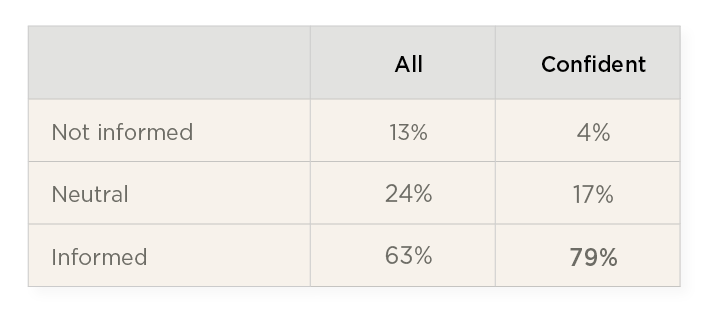
Of all the employees, 63% feel that their company keeps them informed, however, of the confident employees 79% feel that the company keeps them informed. Being informed makes an employee confident and confident employees want to be informed.
We need to keep ICs informed
When looking at confident and informed employees, we found that 69%-70% of senior managers were confident and informed, while only 62%-64% of individual contributors felt the same. More communication needs to reach individual contributors.
Informing ICs and Middle Mgmt will increase confidence in the company
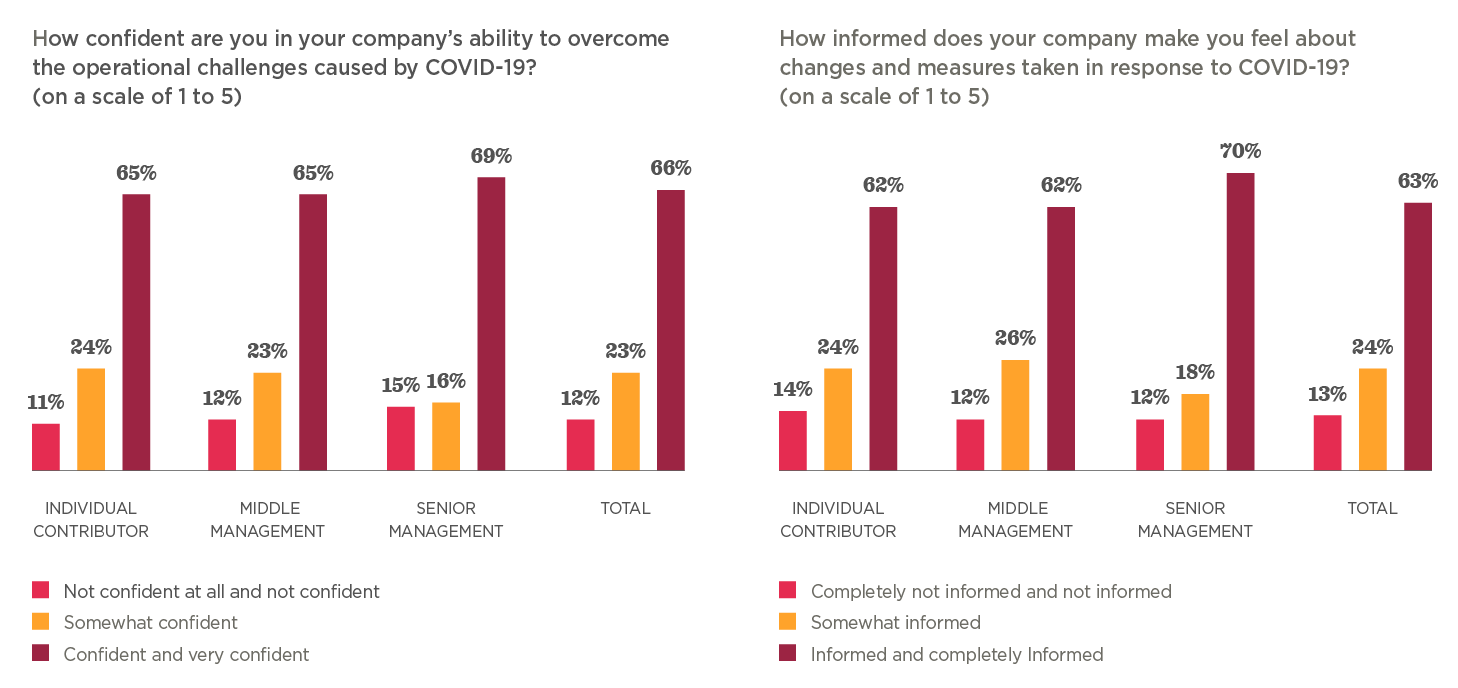
Communication with our managers
An essential requirement for being productive while working from home is regularly communicating with the direct manager. 58% of the employees saying they could go above and beyond, while WFH said that they can always get in touch with their manager and 46% of employees that could not perform their job well at home said that they were not able to get in touch with their manager. 16% of the employees that could not perform their job well at home also said they had a lot of trouble getting in touch with their manager and only 2% of the employees who were able to go above and beyond felt this.
Job performance while WFH and communication with your manager
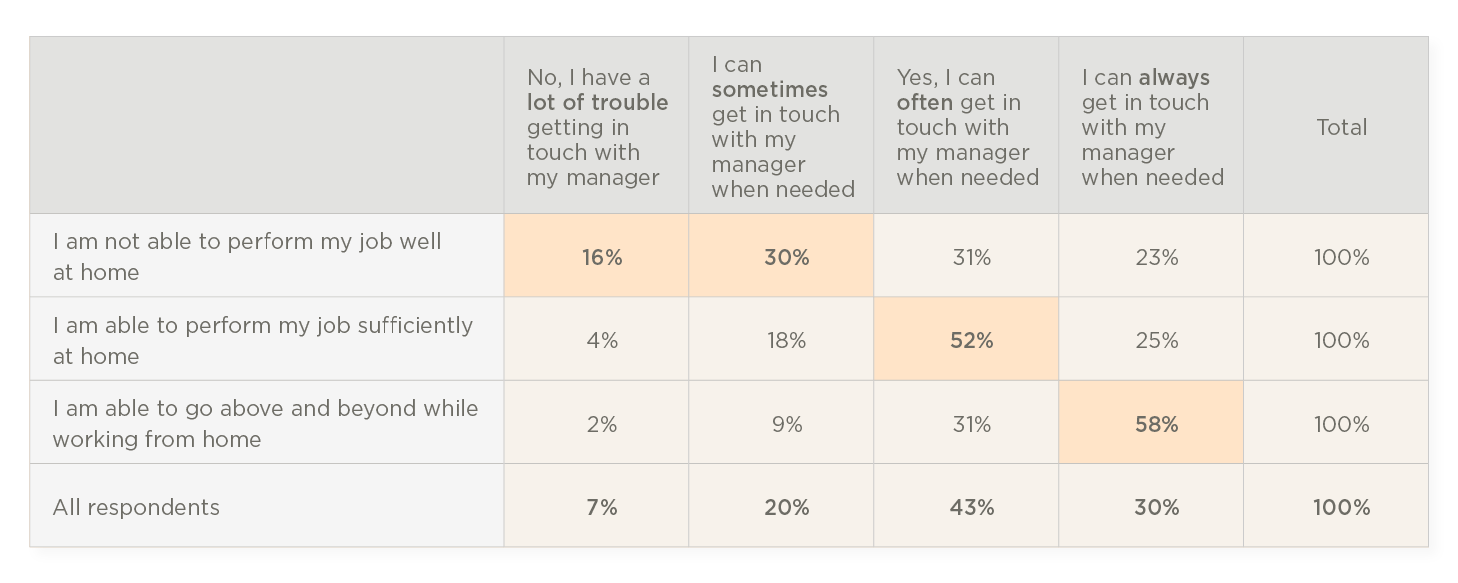
Communication with our teams
Communicating with teammates was harder to achieve while working from home than communicating with managers. 53% of employees said they only had some communications with their teammates. 67% of middle managers felt that they communicated often and effectively with their teammates, more than individual contributors (61%) and senior managers (65%).
Regular and effective communications with teammates
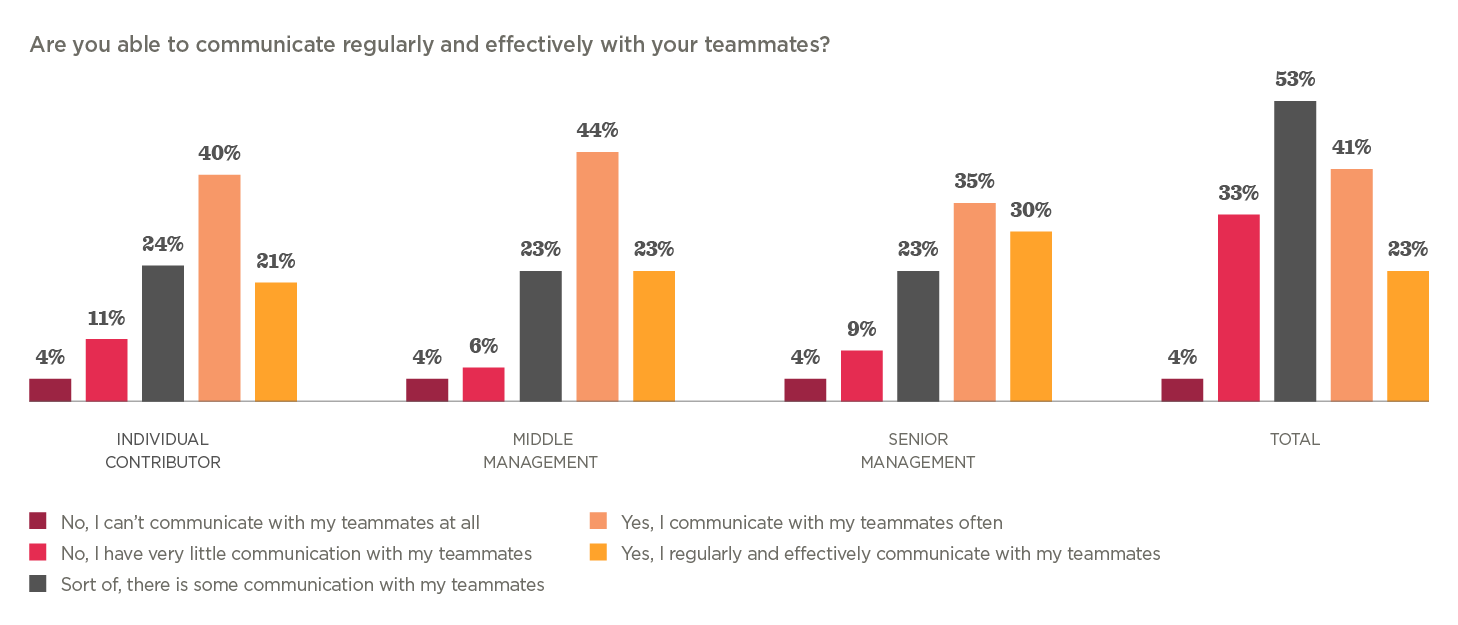
WFH’s impact on productivity
61% of senior managers felt their tasks and priorities were well-defined, while only 45% of middle managers thought so. More work needs to be done to make sure everyone knows what their tasks and priorities are.
Definitions of tasks and priorities while WFH
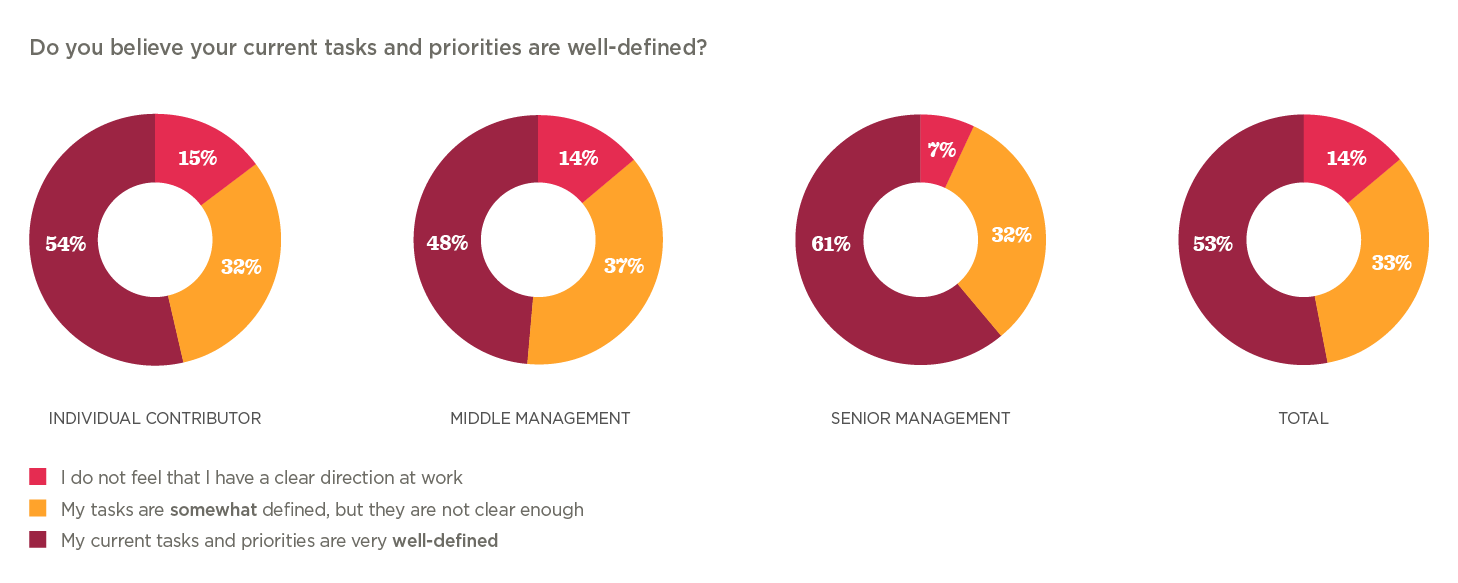
WFH’s impact on productivity
83% of the employees who said they are able to go above and beyond while working from home also said their tasks were well-defined. 35% of employees who said they were not able to perform their job well at home did not have a clear direction at work. Employees and managers alike need to have their tasks and priorities clear to them so they can perform well. This market study highlights this very clearly.
Job performance and task definitions
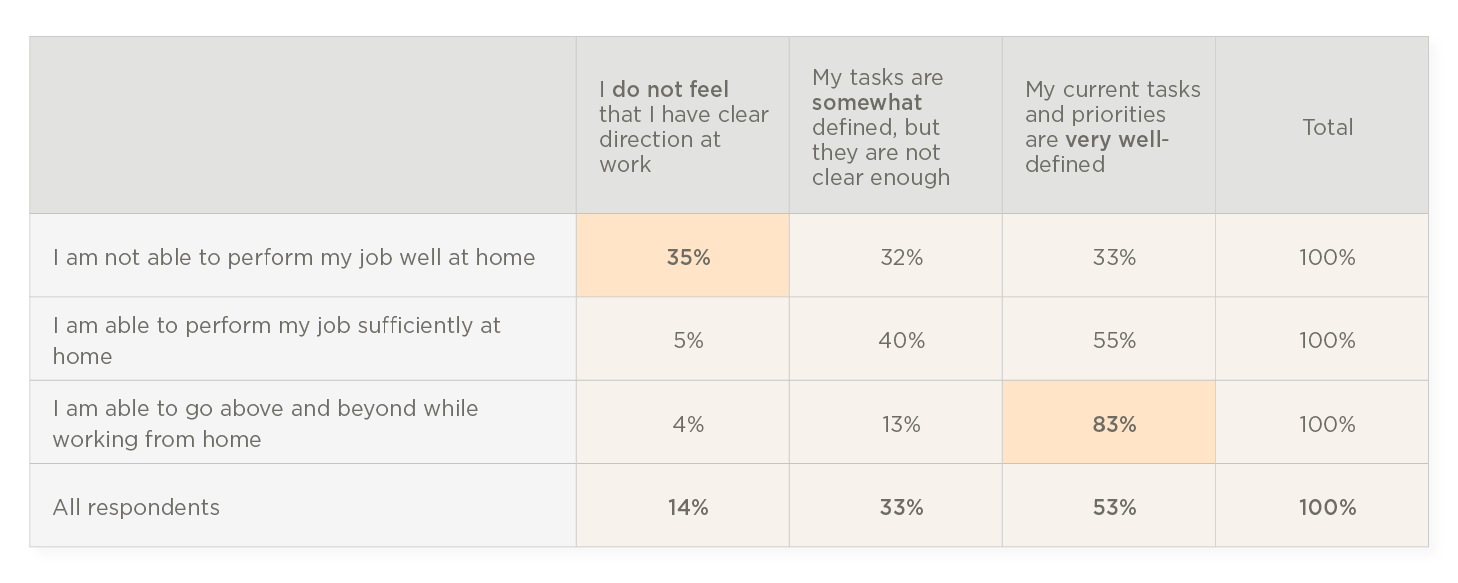
Insights on the WFH experience
72% of employees said they are able to perform their job sufficiently and more while WFH. Only 28% claim that they are not able to do so. In general, WFH well, is possible. 64% prefer to WFH. 36% prefer to WFO. 18% claim high productivity WFH but prefer to WFO, while only 10% claim low productivity WFH and preference to do so. 54% are both highly productive while WFH and prefer to do so.
Segmentation based on ability and preference to WFH
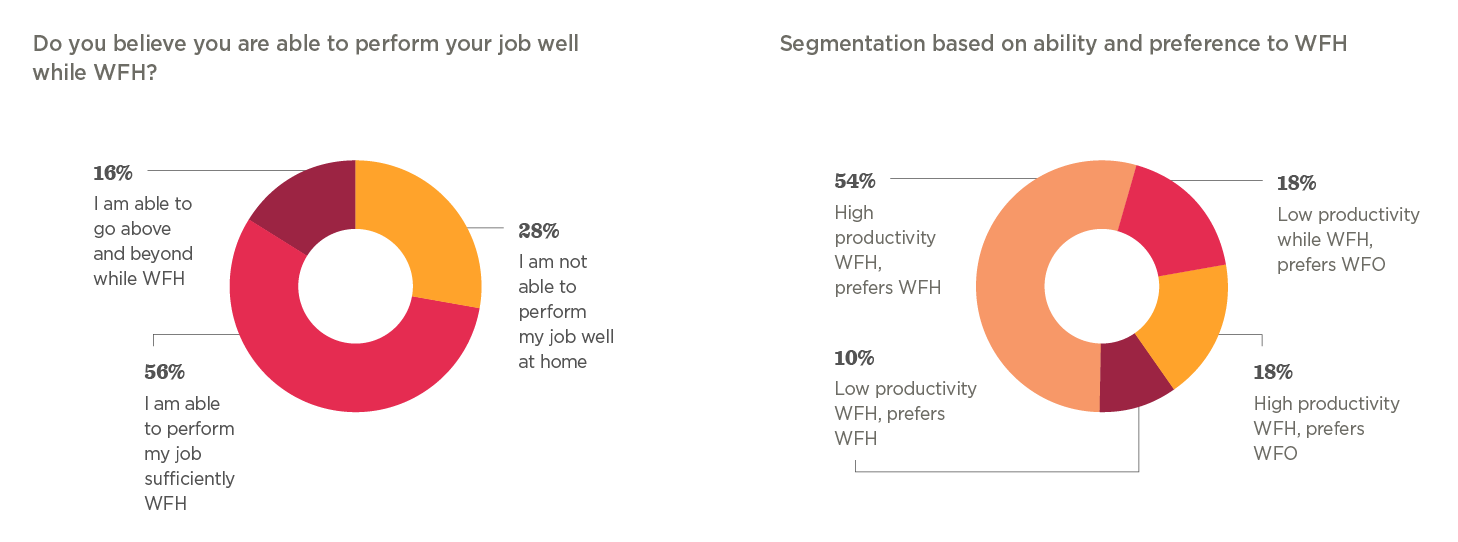
Insights on the WFH experience
15% of women parents and 9% of men parents feel that they are more productive WFH than WFO. However, being a parent did not make employees feel less productive WFH than non-parents. Parenting does not hinder WFH productivity.
The effect of gender and parenting on productivity
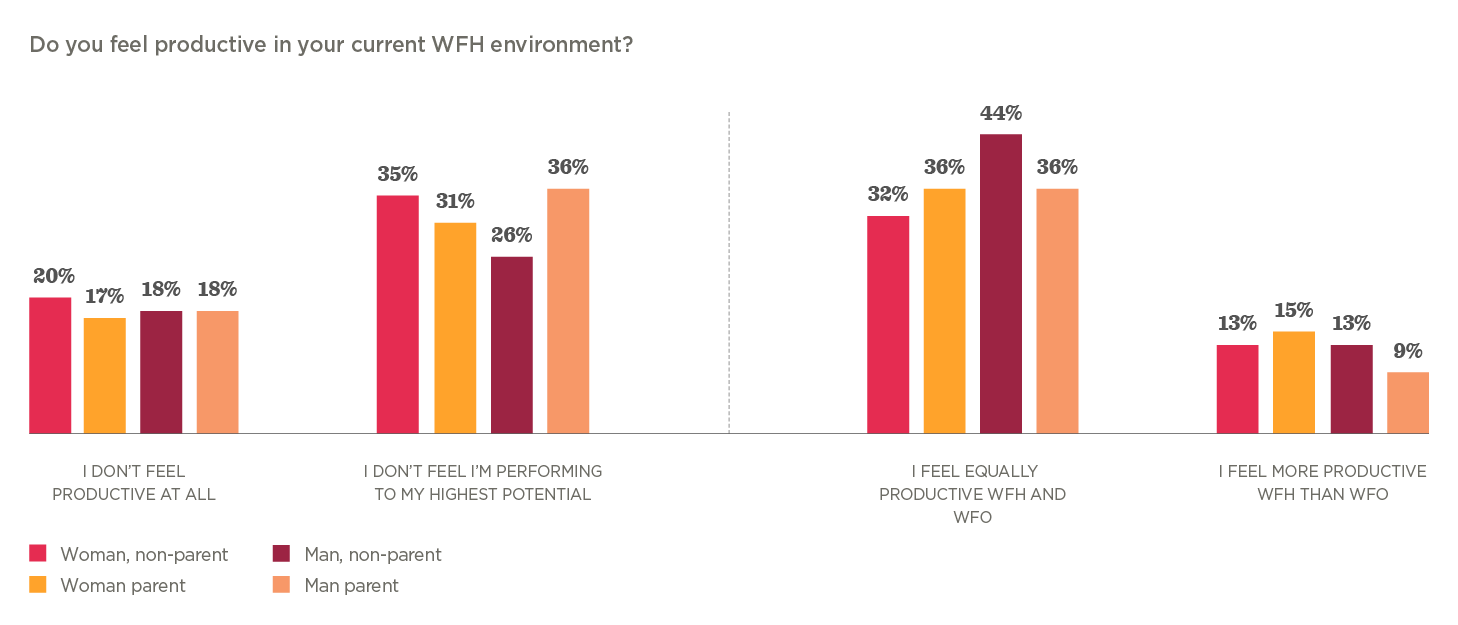
Preferences about WFH/WFO
There is a correlation between the ability to work well from home and the preference to WFH on a regular basis. 88% of employees that prefer to WFH also feel very productive at home, and 51% of employees that prefer to work from the office also admit that they are not able to perform their job well at home.
Preference to be able to maintain working from home?
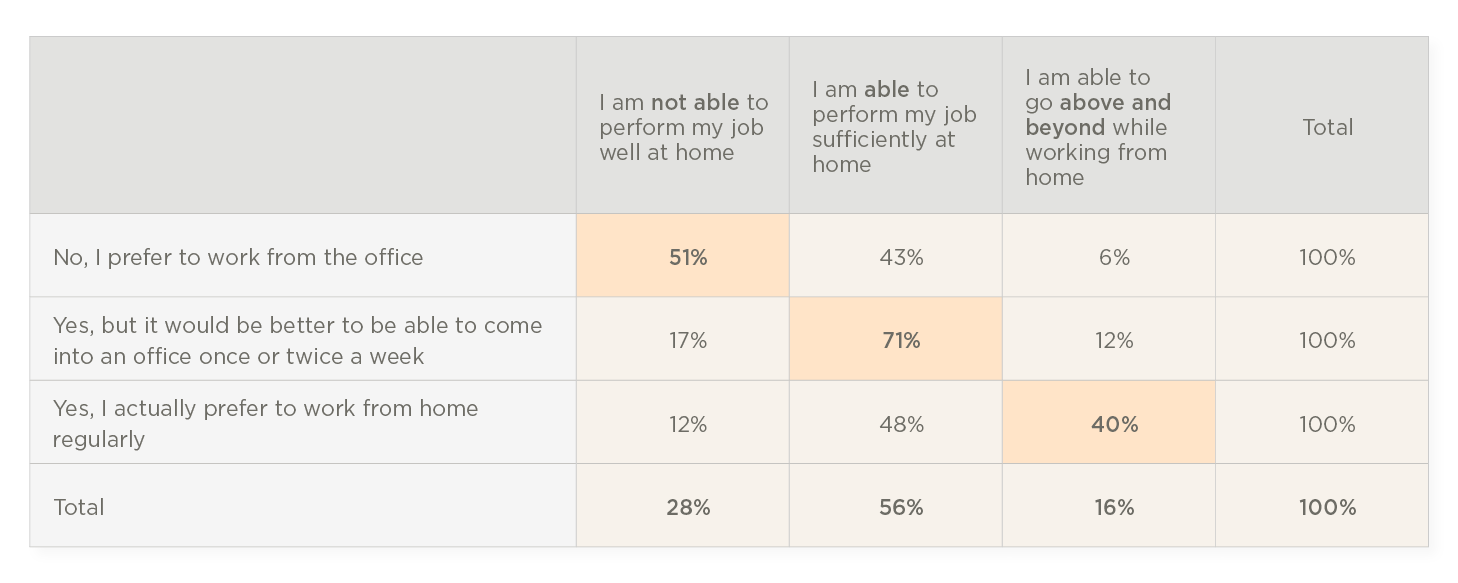
Preparing for the big return
About 40% of all employees say that their favorite aspect of their job is the work they do. This explains how employees stayed productive while WFH: their work didn’t change. However, colleagues play an important role in about 30% of employees regardless of their role, gender, or parenting status. Building connections with colleagues is important.
Favorite job aspect by role, gender and parenting
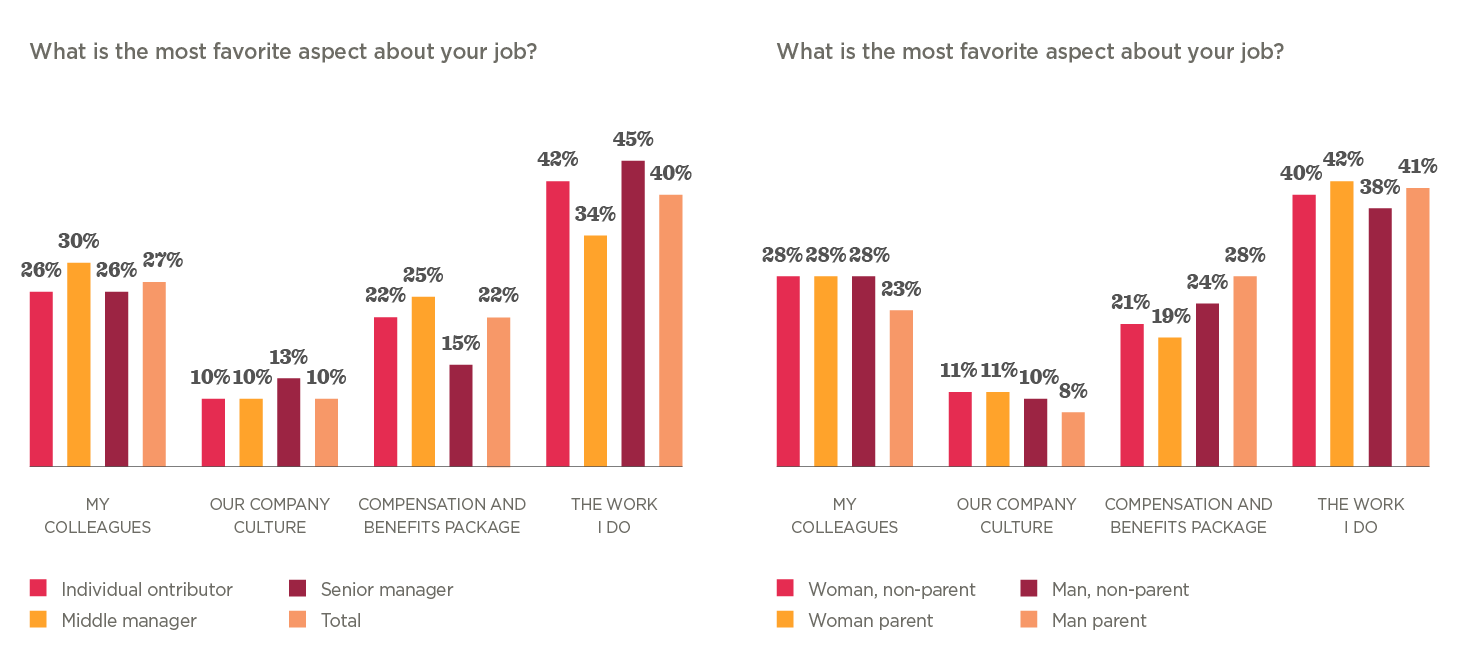
Preparing for the big return
29% of employees between 18-24 years old are most looking forward to seeing and working side-by-side with their colleagues, and 47% of employees between 45-54 years old were just happy to get back to their routine. 24% of employees over age 45 said they missed work-life balance while working from home.
What are you most looking forward to about returning to work?
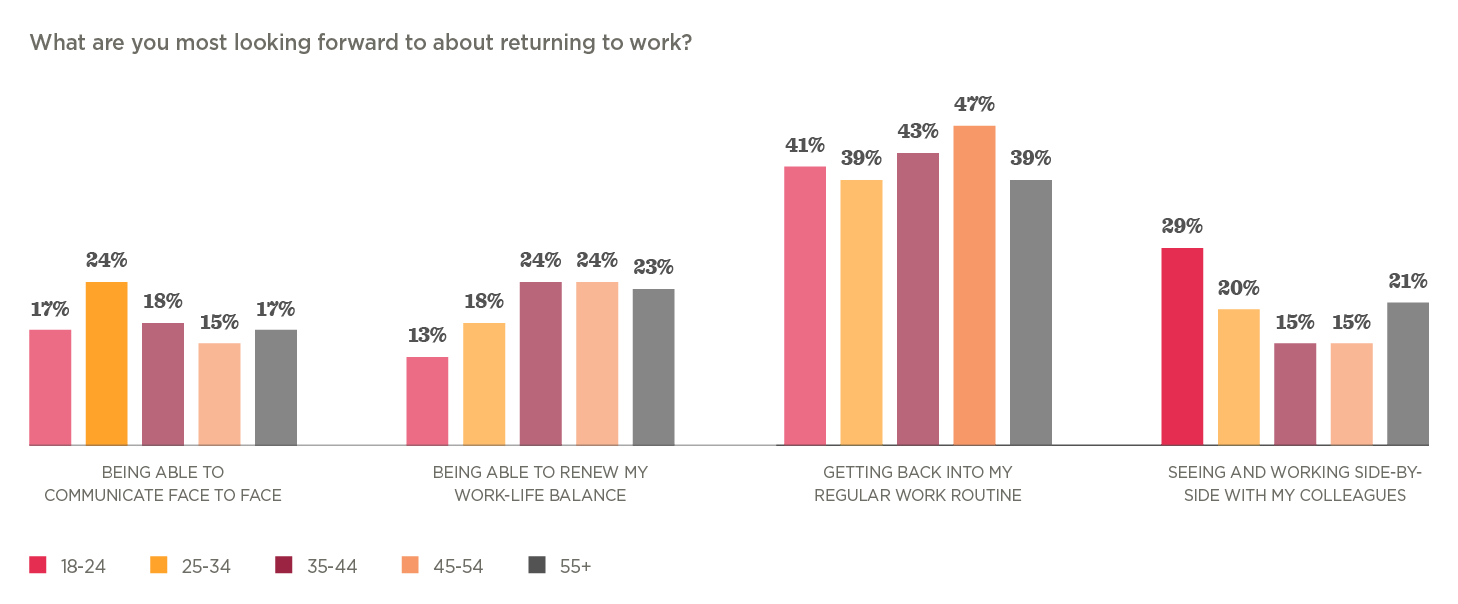
Back-to-the-office
While 60% of employees are comfortable to come back and work from the office, 40% still fell reluctant to do so. The willingness to check and report temperature is high at 73% but there are employees who feel uncomfortable doing so. HR needs to address the ones that are not ready in an empathetic way.
Are people ready to come back to the office?
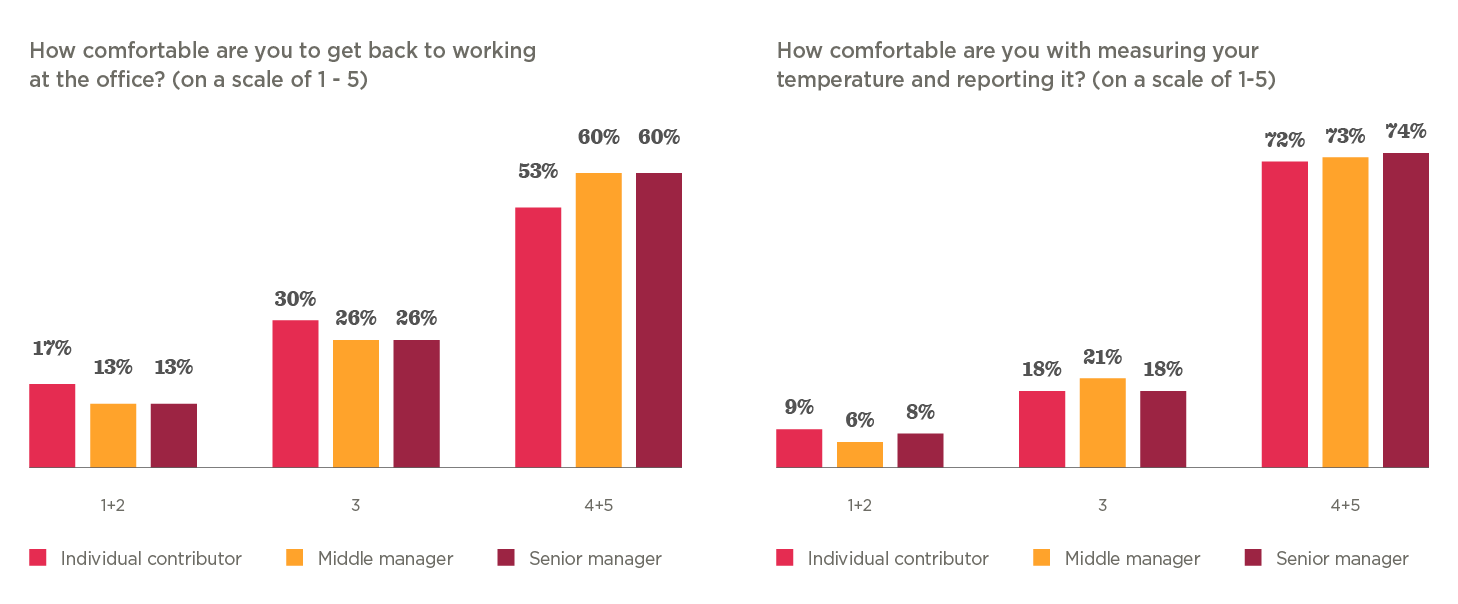
Preference to WFH or WFO
36% of all employees prefer to work from the office, however, only 28% of senior managers prefer to work from the office. 43% of all employees prefer to work from the office twice a week, while 21% of employees prefer to work from home regularly. Middle managers prefer to see their teams in-person—only 19% prefer to work from home.
The hybrid model is the most preferred
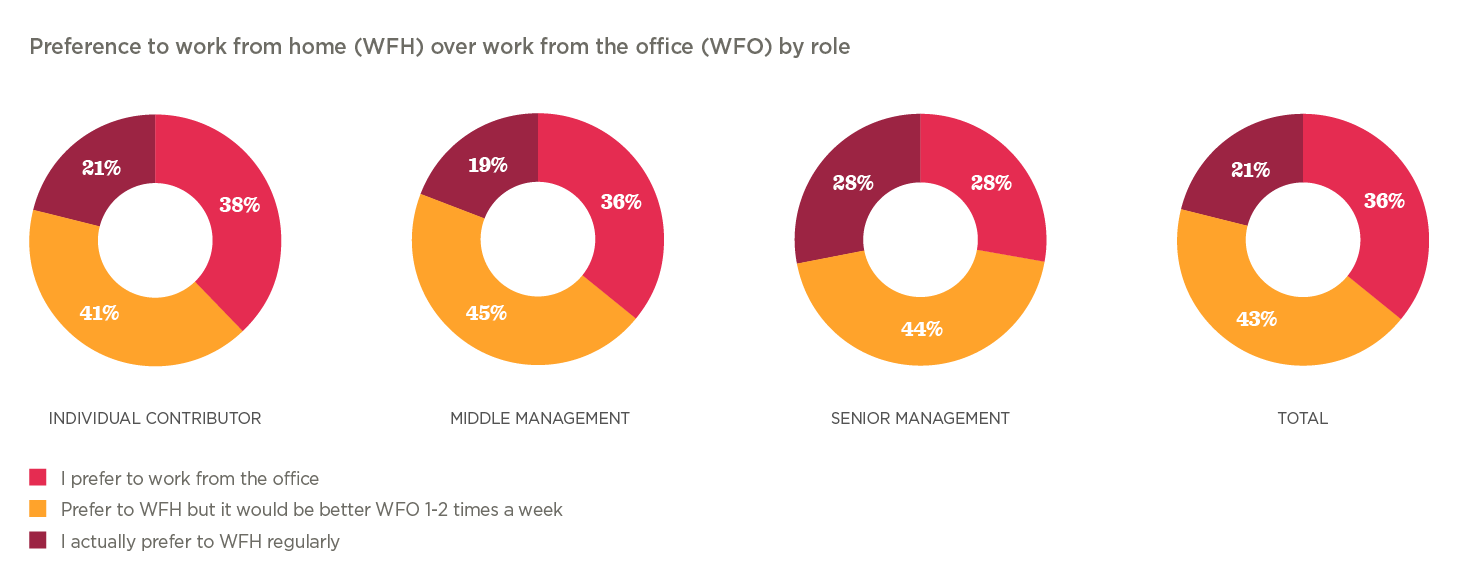
Connecting WFH productivity and preferences
54% of employees overall, including 66% of senior managers, feel productive while working from home and prefer to do so. 18% of employees overall are not productive while WFH and prefer to work from the office, including 21% of individual contributors. 72% of all employees prefer to work from the place where they are most productive, leading us to believe that employees are fully aware of their productivity and want to be productive.
Most people are productive while WFH and prefer to WFH
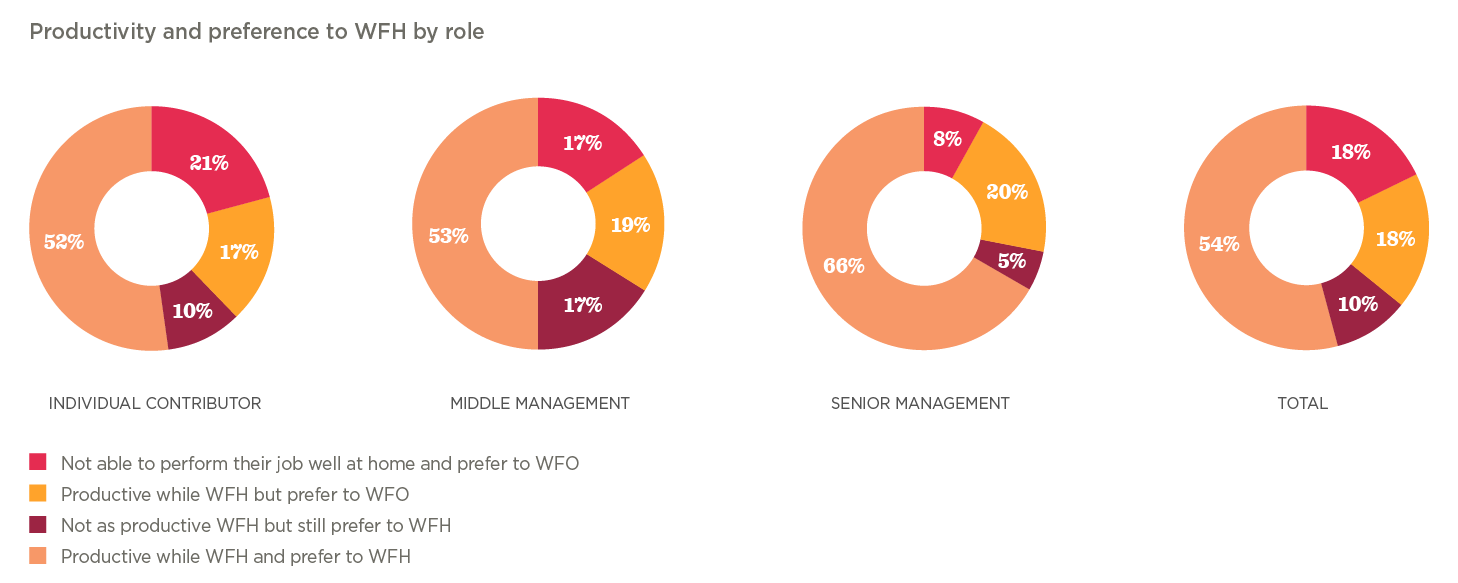
Connecting WFH productivity and preferences
65% of employees that were not able to perform their job well at home prefer to go back and work from the office. 54% of employees that were able to perform their job sufficiently would prefer to work from the office twice a week. 55% of employees who were able to go above and beyond prefer to WFH regularly. Preferences and productivity are generally synced.
Do you believe you are able to perform your job well while working from home?
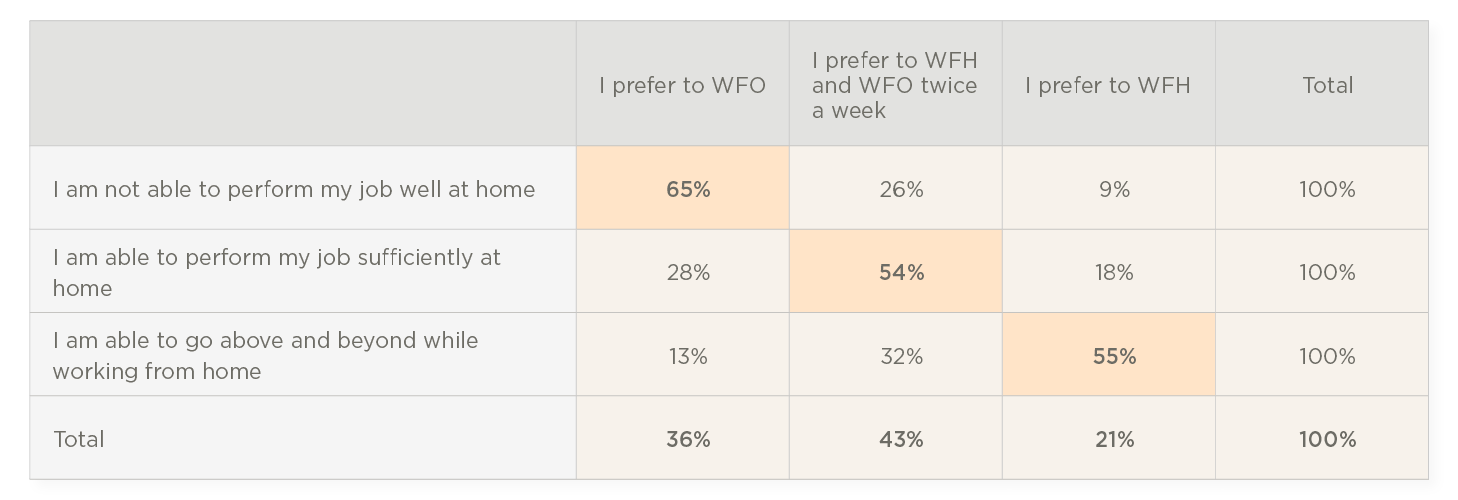
Recommended For Further Reading
Conclusion
What is going to be the future of work?
The COVID-19 pandemic has created the biggest WFH experiment in the world and the experiment proved to be a successful one.
HR teams were at the eye of the storm getting everyone re-situated to work from home, and are now tasked with getting us back to the office.
We were asked to work from home so we can stay safe and healthy, now we want to stay at home because we feel productive while working from home.
What have we learned?
Being at work does not mean being at the office. The new normal is not going to be the same; people expect to be able to work from home after proving they can be productive.
Bringing employees back to work at the office should be a slow and flexible process. People should be allowed to continue working from home while getting used to going back to the office, and not be forced to come back fulltime immediately.
Working from home or working from the office, employees need to communicate with their teammates with their manager and with senior management, The workplace tech stack is helping HR managers foster communication regardless of where people are working. Employees need to connect. communication and tech tools help HR and managers do their jobs.
